Nature Paradise with History
Whether you are interested in rock formations or plants, like to observe game or birds, want to walk in the footsteps of history or get to know the culture and everyday life of the inhabitants – or just want to let the landscape work on you and take a really deep breath: The Naukluft has something for everyone.
Geology
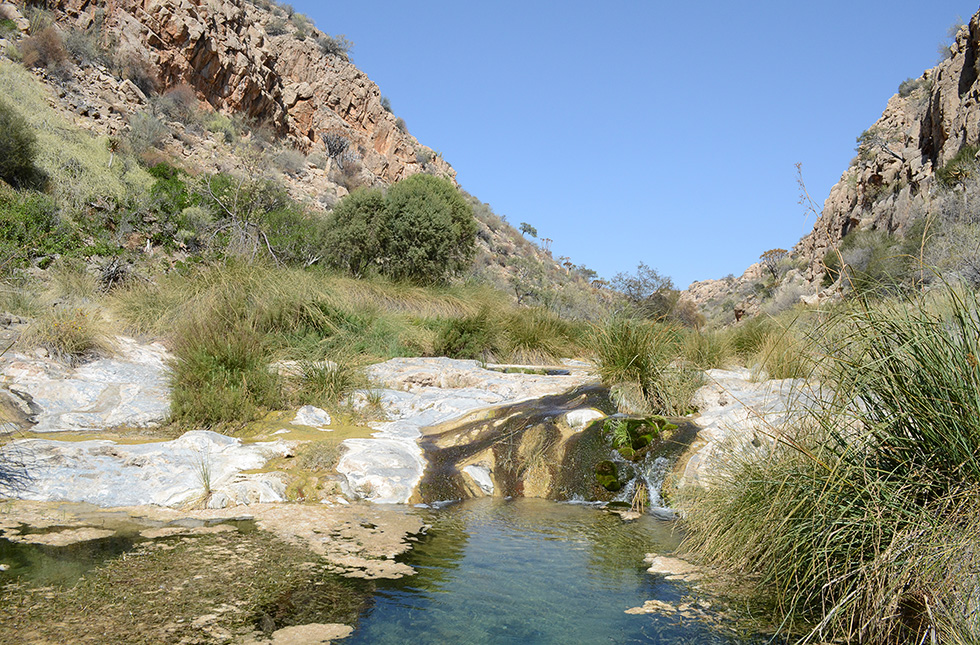
Stream and rock pool in the Quiver Tree Gorge at BüllsPort. (Photo: Kiki Beelitz / BüllsPort Lodge & Farm)
The Naukluft mountain massif forms part of the Great Escarpment between the high plateau in the interior (about 2 000 m above sea level) and the eastern plains of the Namib Desert (400 – 500 m above sea level). Also known as over-thrust mountains, its upper layers of dolomite are around 540 million years old.
During the collision of two cratons (parts of the Earth’s crust) the mighty Damara Mountains pile up. The rocks on its southern flank, roughly at the location of today’s Gamsberg, start to shift. Based on saline sediments, which are turned into a gel-like state by the enormous pressure, the entire massif of 68 km by 28 km glides a distance of about 78 km, until approximately 495 million years ago it comes to rest at its current location.
Phases of higher precipitation lasting millions of years cause a process of karstification, where water dissolves calcrete in the dolomite and creates passages and caves, which today protect it from evaporation. At various points, rainwater emerges in the form of springs. This is why you’ll find water-bearing streams throughout the year in the Naukluft.
How to experience: Quiver Tree Gorge, Bogenfels and Bull’s Head Trail as well as Naukluft Safari and BüllsPort Discovery Ride
Flora
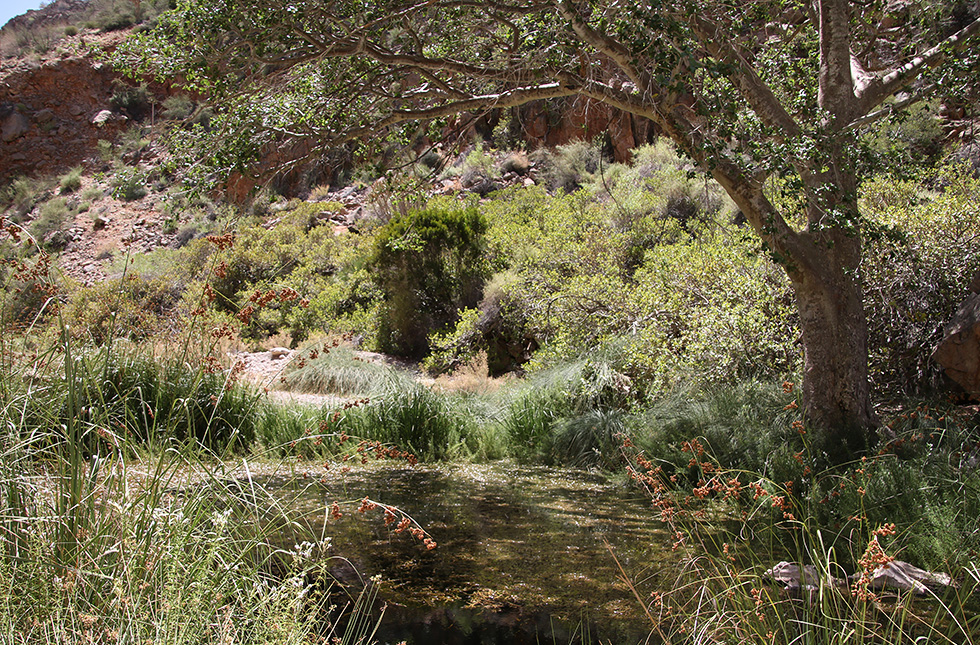
Lush vegetation around a rock basin in the quiver tree gorge at BüllsPort. (Photo: Sven-Eric Stender / Bush Telegraph Namibia)
Rocky cliffs, mountainous slopes, streams in shady ravines and dry riverbeds in broader valleys – with such a diversity of habitats, it is no wonder that the Naukluft has an exceptionally rich variety of plants. In addition, two biomes meet at the Naukluft, the Nama Karoo and Namib Desert.
With an average of less than 120 mm rain per year, it is an extremely dry environment. During the course of evolution, many plants have creatively adapted to these harsh surroundings, including succulents such as the quiver tree (Aloidendron dichotomum), candelabra euphorbia (Euphorbia virosa) and Bushman’s hat (Hoodia gordonii).
Other well-known arid area specialists found here are the moringa (Moringa ovalifolia), some commiphora species, Bushman’s candle (Sarcocaulon patersonii), and last but not least, the resurrection bush (Myrothamnus flabellifolius). At streams and rock pools on the other hand, you will find lush vegetation ranging from mighty fig trees (Ficus sycomorus) to aquatic plants.
Fauna
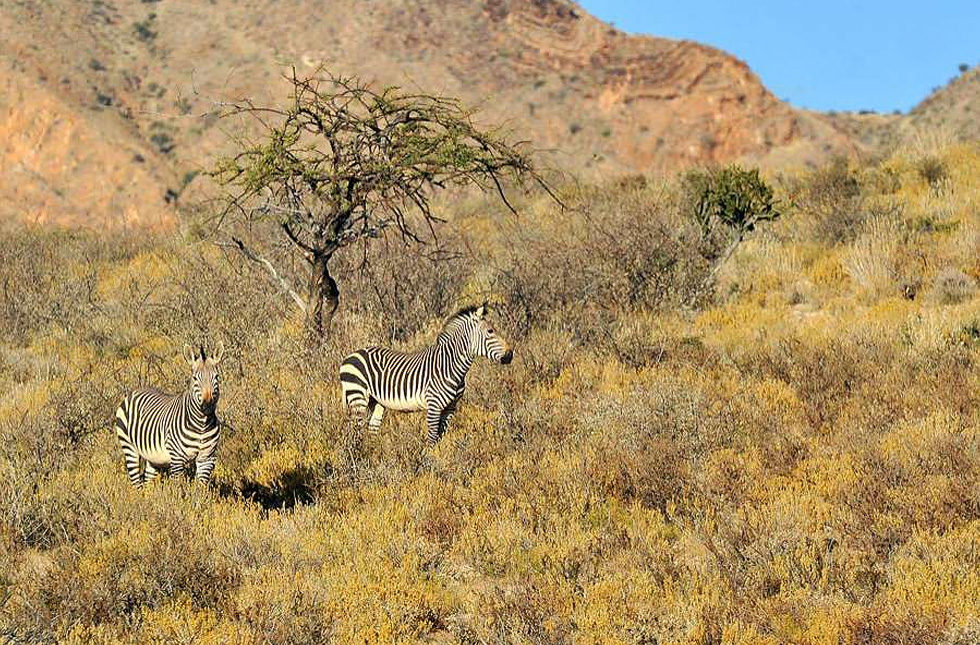
Hartmann’s mountain zebra in a high valley of the Naukluft at BüllsPort. (Photo: BüllsPort Lodge & Farm)
The variety of habitats and the open water ensure that the Naukluft is just as rich in wildlife as it is in vegetation. Mammals alone make up 50 different species. In the valleys and the plains at the foot of the mountains, you can see springbok and gemsbok, kudu, baboon, warthog and bat-eared fox.
The mountains are also populated by baboon and kudu as well as klipspringer, steenbok and rock dassie, and of course the Hartmann’s mountain zebra, an endemic species that almost only occurs in Namibia. Predators include leopard, caracal, African wildcat and spotted genet.
In addition, the Naukluft is a true bird’s paradise: More than 200 species have been spotted so far, including Ludwig’s bustard (Neotis ludwigii) and crimson-breasted shrike (Laniarius atrococcineus), birds of prey such as rock eagle (Aquila verreauxii) and augur buzzard (Buteo augur), as well as water birds such as the hamerkop (anvil head or hammer head; Scorpus umbretta). Supplementing many reptiles, there are also amphibians and fish in the Naukluft – housed in its water-filled rock pools.
How to experience: Hiking Trails and Horse Rides, as well as Farm Tour
Nature conservation
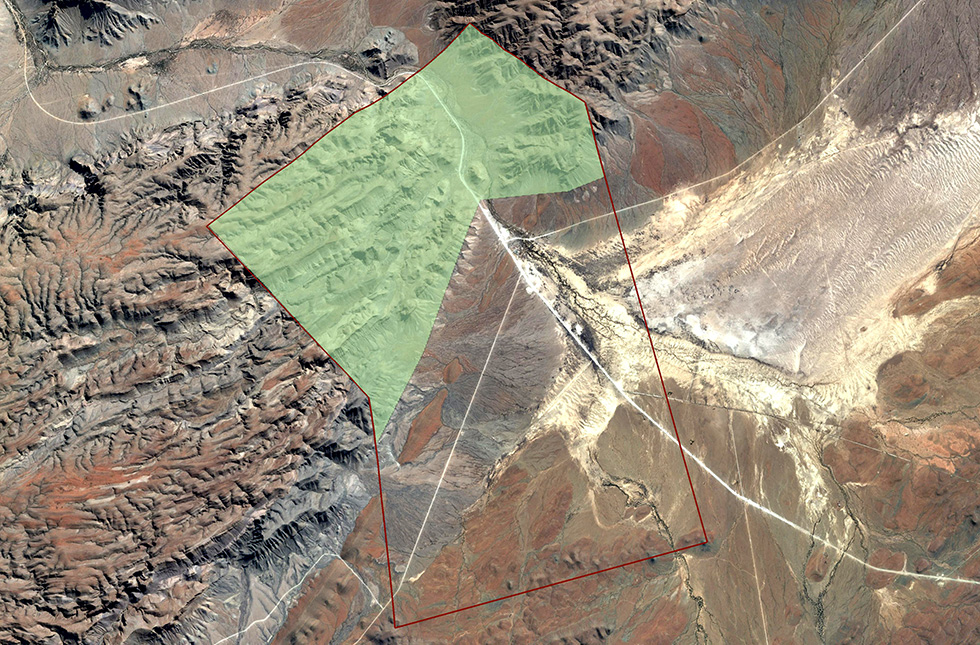
The BüllsPort farm (99.34 km²) with its nature reserve (43.4 km²) and agricultural areas (almost 56 km²) for cattle and sheep. Map: BüllsPort Lodge & Farm (Source: Google Earth)
The mountains for game, the plains for livestock. This has been the basic principle of BüllsPort Lodge & Farm for decades. So that agriculture can help finance nature conservation. Because the guest company’s contribution is not enough to cover the costs.
BüllsPort has deliberately limited the number of its rooms and campsites and is operating as environmentally friendly as possible. On the 14 paths through our nature reserve, hikers, riders and mountain bikers leave nothing behind but their foot, hoof or tire tracks. It is not for nothing that BüllsPort Lodge & Farm has been awarded all 5 out of 5 possible desert flowers from the environmental organisation Eco Awards Namibia.
The cost of nature conservation is high. In nature reserves of limited size, you cannot leave nature to its own devices. Constant game management is necessary to preserve biodiversity and to prevent overgrazing, which would permanently damage the flora. At BüllsPort, the condition of game and plants is regularly checked on patrols.
We have drilled three boreholes in the mountain area so that the game does not only have to rely on the springs and watercourses in the gorges. This way the area is grazed more evenly. The wind turbine and solar pumps have to be checked regularly and repaired now and again. The same applies to around 20 km of external fence that run through difficult-to-access terrain.
The fence is often damaged, especially on the border with the national park – mostly by mountain zebras. No wonder. There are an estimated 4,000 zebras in the park. That is double the upper limit of 2,000 animals that experts have set based on the carrying capacity of the area.
In search of food, the mountain zebras push into BüllsPort’s nature reserve – and from there down into the plains that are set aside for sheep. In this way, nature threatens precisely that source of income that helps finance its protection. And this is happening especially in times of drought, when the pasture has to be strictly rationed through carefully planned use of the kamps (fenced areas for grazing).
Nature lovers at home and abroad can help protect the home of quiver trees and mountain zebras in the Naukluft mountains at BüllsPort – with a sponsorship. You can find more about our “My Quiver Tree” campaign here.
History
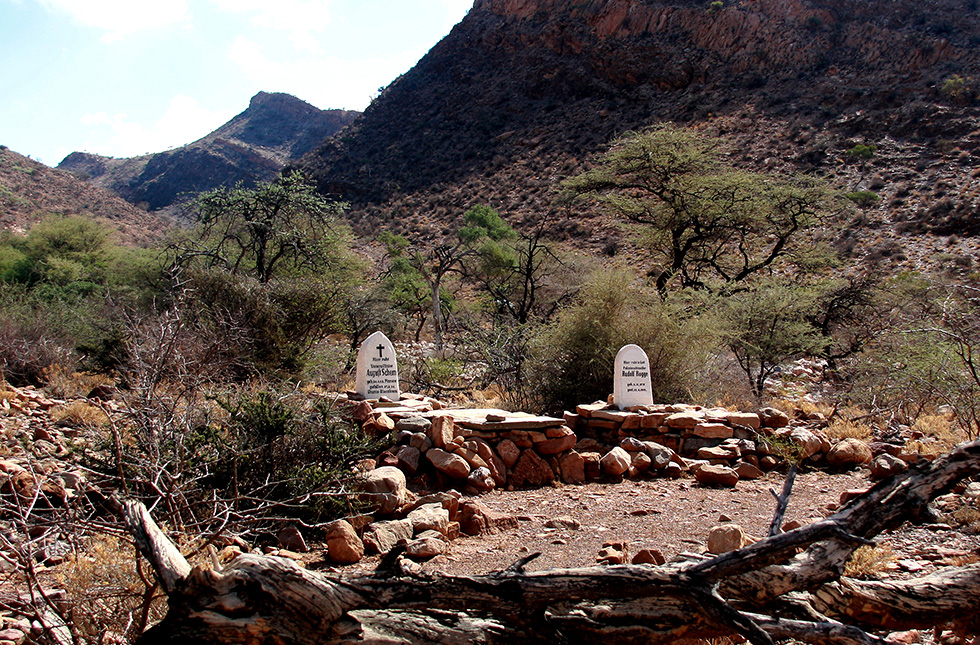
Graves near the ruins of the former German police station at BüllsPort. (Photo: Sven-Eric Stender / Bush Telegraph)
The fact that humans have been living in the Naukluft for over 50 000 years is evident through the datable residues of hearths in caves and other sheltered places. There are also many sites where stone tools were made. However, rock art is scarce – at least at BüllsPort.
This place was ideally positioned for hunters following game: Here, the animals migrate through the narrow valley of the dry Tsondab River, between the plains of the highlands and the grasslands of the eastern Namib.
Thus the name Naukluft, which originates from the Afrikaans term “nou kloof” = narrow gorge, allthough the first syllable of the German word does not make sense at all and the second one actually means “gap”. Even worse is the malapropism of the original name of the valley’s entrance: Bull’s Mouth, the English translation of “Gob Ams” (Khoekhoegowab / Nama language) turned into the Afrikaans Bul se Poort (Bull’s gate) and finally mutated into the meaningless German word Büllsport (because “u” in Afrikaans sounds like the short German umlaut “ü”) – which, on top of it, suggests the incorrect hyphenation of the word in German as Büll-sport. Hence our preferred spelling: BüllsPort.
How to experience: Archeology Trail, Bull’s Head Trail
The different languages indicate that this area has an eventful history: The San (Bushmen) are displaced by Nama groups from the Cape at the beginning of the 18th century; at the beginning of the 19th century explorers, hunters and traders from Europe move through the surroundings; while in 1868, Basters (coloured descendants from Khoe and Europeans) on their trek from the Cape northwards settle in the area near Rehoboth. In 1884, the terrain that makes up today’s Namibia is declared a German Protected Area.
In 1894, the Oorlam-Nama under the leadership of Kaptein Hendrik Witbooi engage in fierce battles with the German Schutztruppe in the Naukluft mountains. Evidence of combat is the grave of a Schutztruppler (German soldier) near the old police station. A second grave commemorates a police officer killed in 1915 in the wake of the Baster uprising, while South African troops as Allies of England in the First World War advance from the south into the German colony.
How to experience: Ruins of the police station and graves at the starting point of the Köcherbaumschlucht Trail
The war also has an impact on the first attempt to farm at BüllsPort. While the farmer serves as reservist in the Schutztruppe to fight against the South Africans, the farm is plundered by Basters and Nama. The next farmer does not have much luck either – he is interned in the Second World War by the mandatory power of South Africa.
In 1950, farmer widow Anna Sauber acquires the farm BüllsPort for her son Hermann, who, together with his wife Hilde, builds it up piece by piece, despite several years of drought. As from 1984, their son Ernst gradually takes over the management. After a severe drought, Ernst and his wife Johanna from Germany open their guest business in 1993: BüllsPort officially becomes a guest farm – with cattle and horse breeding.
Years of drought and an invasion of mountain zebras in grazing areas of the farm force Ernst to sell his core herd of 57 cattle in 2021. Instead, he focuses on the sheep farming he started a year earlier.
How to experience: Farm Tour
The impetus for this step is the Independence of Namibia in 1990, an event that results in increasing numbers of tourists visiting the country. This is a blessing for BüllsPort, because even in drought years, which set narrow limits to farm operation, the landscape does not lose its charm and visitors are able to enjoy the area’s natural beauty.
An additional attraction is the fascinating mountain world of BüllsPort, which captivates hiking and horse riding fans alike. The neighbouring nature reserve attracts many visitors, too. Proclaimed in 1968 as the Naukluft Mountain Zebra Park, it protects the unique flora and fauna, in particular Hartmann’s mountain zebra (Equus zebra hartmannae), which occurs almost exclusively in Namibia. In 1979, the reserve is linked to the Namib Desert Park (founded in 1907), and since then it is part of the Namib Naukluft Park, the largest nature reserve in Namibia with an approximate area of 50,000 km².
Newsletter "Naukluft Mail"
Straight from the NAUkLuFT to your mailbox: News, information and exciting stories about the guest business and farm operations of BüllsPort, as well as the mountains of the NAUkLuFT. Subscribe to our quarterly newsletter "Naukluft Mail".
If you want to see what's going on at BüllsPort every now and then:


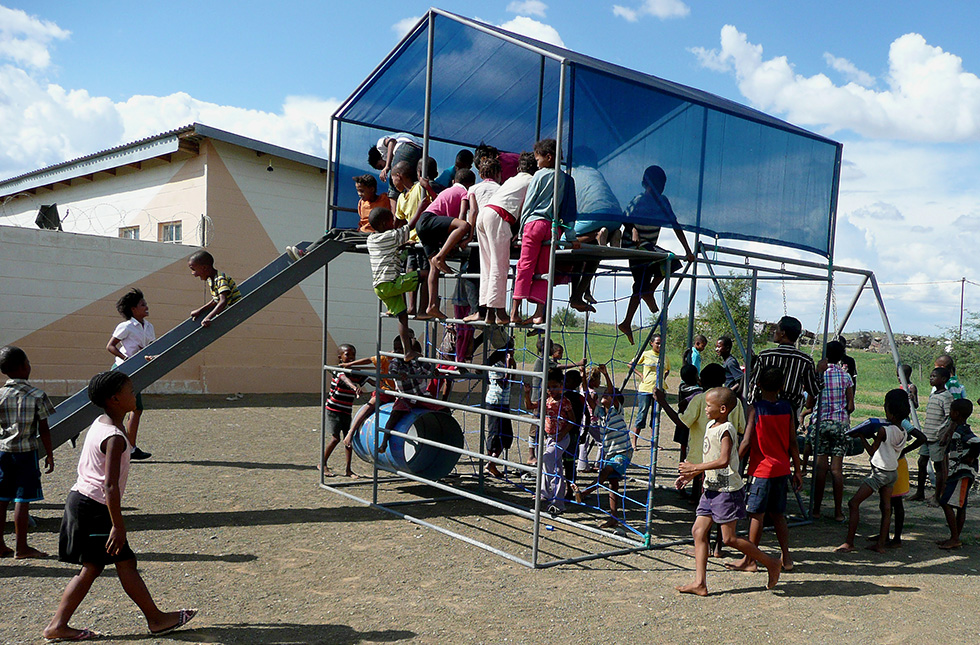

Residents / Social
Playground of primary school Nabasib. (Photo: Büllsport Lodge & Farm)
BüllsPort also invests in the future: The Naukluft Foundation, founded in 2005 together with Ababis Guest Farm, supports the Nabasib State Primary School located 15 km away. It offers the children of employees working on surrounding farms a regulated instruction from grade 1 to 7.
The school can be visited, subject to a timely request. It has a powerfully voiced choir, which has evolved excellently under the guidance of dedicated teacher Elfrieda Plaatjies and won the first prize in regional school competitions.